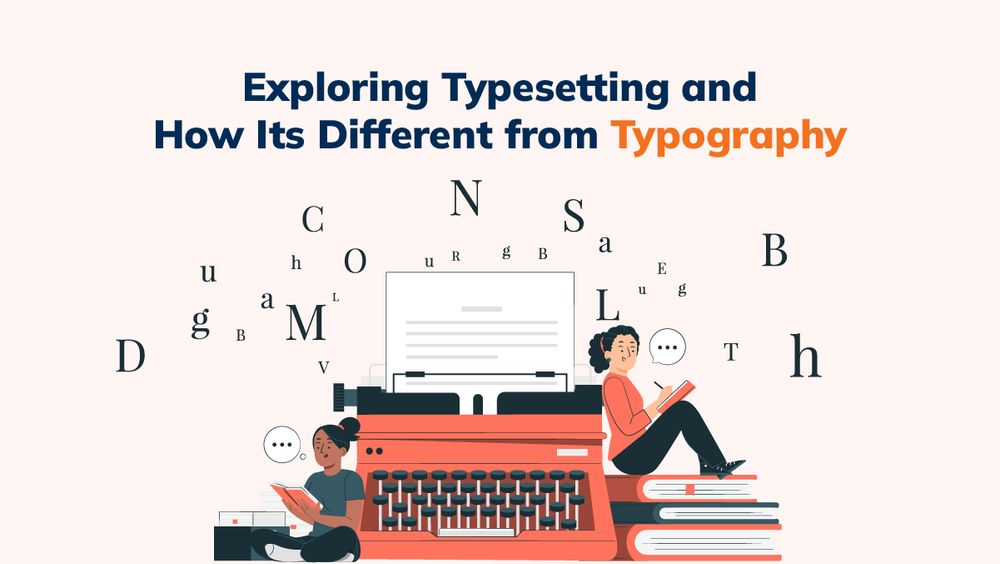Exploring Typesetting and How Its Different from Typography
Have you ever observed that some books are engaging? It's not only because of what's written in them but because of their overall print, font, font size, and the evenly distributed space. This is the magic of typesetting! Even professionals often mix up the typography and typesetting, thinking they are the same. But many aspects underline the difference between typesetting and typography. In this blog, we will learn typesetting meaning, typesetting vs typography, and how our online graphic designing courses can help you learn both in detail.
What is Typesetting?
Typesetting is setting the format of text on a page for better visual communication by improving readability and providing the best reading experience to the reader. A typesetter usually makes decisions on the size of margins, the font spacing, font type, font size, and the styling of the beginning of the chapter.
The common word for composing books these days is "formatting," which seems to imply that the job requires little skill. Print quality has increased dramatically, and even a Word document looks pretty good, at least to the untrained. At its core, composition is about visual communication. Underestimating the importance of layout is a mistake as it will affect the readability of your book. A bad layout is equivalent to a rusty train track that bash and cracks all over the page, erratically leading the reader in and out of the story.
This sounds basic, but it's not. In fact, layout is one of the hardest parts of graphic design. Paragraph breaks in the wrong place can disrupt the mental flow of the reader. There's a lot more to composing than most people realize.
Typesetting Vs Typography
Typesetting is commonly confused with typography, but let's shed some light on the major difference between typesetting and typography.
- In typography, the arrangement of text and its presentation is based on the general rule of the language. Whereas in typesetting, the designing expert arranges and designs the text to improve its visual appeal. The typography arrangement may not necessarily follow the general rule of language.
- The font styles used in typesetting are pre-designed and commonly used. Typesetters must also follow certain rules to choose the relevant font style matching the content and audience. On the other hand, typography is quite associated with calligraphy, so designer fonts are freely used in typography.
- In typesetting, alignment and indentation are crucial. The main job of a typesetter is to format the text according to the predefined rules to maintain the proper alignment and indentation. In typography, alignment and indentation are secondary. The primary aim of typography is to make the text look unique and visually appealing to engage readers.
- In typesetting, the new style and fonts are not used, whereas in typography designer may opt for designing and using custom forms to improve the visual appeal.
- The test is kept static in typesetting, but the text can be in 3D and have effects and motion in typography.
Why is Typesetting Important?
Typesetting is more about order than style. Imagine setting up a bookshelf. What is much better? Neatly arranged books on the shelf or a pile of books mixed with each other on a floor? Neatly arranging text is nothing different than arranging the books on the shelf.
With better typesetting, the content appears neat and well-defined and has directly impacts the reader's perception. The font and typesetting combine to offer a distinct look and appeal to your content. The typesetting process is quite crucial, and professional typesetters are the experts who can set for a different type of content and detect even the smallest mistakes that a normal person may miss.
We offer the best knowledge on typesetting through our Online Indesign Course. This course, we help you learn to set and format text and create interactive documents such as visiting cards, brochures, booklets, and more. Get in touch with us today to learn Adobe Indesign in detail.
Top Courses:
Game Design Courses Online | Online Graphic Design Courses | Online Animation Courses | Online VFX Courses | Premiere Pro And After Effects Course | Photoshop And Illustrator Course | Graphic Design Full Course | Adobe Illustrator Course with Certificate | Online CorelDRAW Course | Adobe XD Tutorial in Hindi | CorelDRAW Course In Hindi | Image Processing Online Course | Photoshop Course in Hindi | Adobe XD Essentials Certification | Indesign Online Course | Nuke Compositing Course | Adobe Premiere Pro Course | After Effects Course Online | Motion Graphics Course In Hindi | Color Grading Course | Maya Animation Course | Architecture Visualization Course | 3D Modeling Certification | ZBrush Online Course | Game Environment Modeling Course | After Effects Course in Hindi | Adobe Illustrator Course in Hindi

